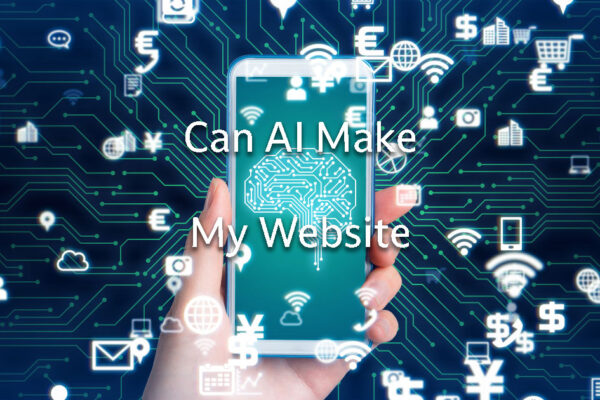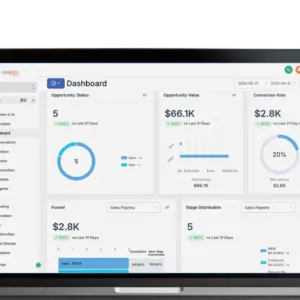Can I Use AI to Make My Website? Well… Yes. But there’s a catch.

Filters
Results
It’s no secret that AI is changing the digital game. From content to code, it’s faster, cheaper, and a hell of a lot more accessible. AI website builders and design tools are now mainstream. And sure, they can whip up a semi-decent site layout in minutes. But does that mean you should let AI take the wheel completely?
But, haha, slow down tiger! Not so fast…
To create a website that actually works—one that converts, ranks, and grows with your business—you need more than just automation. You need strategy, storytelling, and a deep understanding of your users. That’s where Growth-Driven Design (GDD) comes in.
And spoiler alert: GDD is user-centric… SO it still needs humans.
The Rise of AI in Web Design
AI isn’t just a buzzword anymore. It’s baked into platforms like Wix ADI, Shopify Magic, and even Canva. These tools promise quick builds with less effort. No code, no worries.
But while AI can handle repetitive tasks, it doesn’t know your customer. It doesn’t think like a strategist. It can’t read between the lines of user feedback or test subtle tweaks to increase conversions. That’s still on you, or your web partner.
What AI Can Do
Let’s give AI some credit. When used right, it can:
- Speed up initial design layouts
- Help personalise content based on user behaviour
- Generate basic code or design suggestions
- Identify bugs or UX issues fast
And yep, all that saves time and money.
How AI Website Builders Work
Most AI website tools ask a few quick questions: What’s your business type? What colours do you like? Do you want a shop?
Then boom—your draft site is done. AI analyses common design patterns, chooses a layout, suggests content, and even plugs in images. Some tools offer ongoing tweaks based on user data too.
Sounds slick, right? But here’s the thing—it’s generic. That’s fine for a placeholder or a side project. But if you’re serious about standing out, you’ll need more depth.
AI + GDD = Smarter, Not Lazier
Here’s where the magic happens. AI shines when you combine it with a user-centric, data-driven approach like GDD. Imagine using AI to build a launchpad site fast—then applying real-world user data to improve it month by month.
This approach turns your website into a living, evolving asset. Not a static brochure.
With GDD, AI can help:
- Test layout variants
- Personalise CTAs in real time
- Track and respond to user actions
- Save time on dev work so your team can focus on strategy
The Real Benefits of AI to make a Website
Used smartly, you could say AI offers:
- Faster go-live dates
- Lower development costs
- Customisation at scale
- Less grunt work for your team
It can also help you better understand what users want—by analysing behaviours, not just demographics. That means better content, smarter design, and improved conversion paths.
But Let’s Get Real—AI to Make Website it NOT Perfect
In the past, we’ve asked Will AI change web design? And in truth, it already has in many ways… AI, however, doesn’t think critically. It doesn’t ask “why” like a good designer does. It doesn’t push back when your idea isn’t user-friendly. And it definitely doesn’t sit in a workshop mapping your ideal conversion journey.
It also comes with challenges:
- Data privacy concerns (especially with NZ’s Privacy Act)
- A steep learning curve for some tools
- Risk of “cookie-cutter” websites
- No true emotional intelligence
So, while AI is a powerful ally, it’s not your whole team. Think of it as your intern, not your creative director.
The Future: More AI, More Strategy
AI isn’t going anywhere. It’ll keep evolving—faster than we can keep up some days. Expect deeper integrations with VR, voice search, and real-time personalisation. You’ll probably see more websites that can adapt dynamically without a human lifting a finger.
But remember, your website should reflect your brand, your voice, and your unique edge. That doesn’t come from a template. So if you’re thinking, AI will put an end to Google, Content and more… ? Then you’re mistaken. If anything, it’ll have the opposite effect, and it will make it even more difficult to optimise for real-life people. Things such as SEO and SEM will potentially become even more crucial to get right. And User Experience will be the key to success
Final Thoughts
AI can technically build a website. But it takes strategy, data, and design thinking to build a great one. If you’re serious about growth, user experience UX/UI Design must still lead the way.
Use AI to amplify what you’re already doing. Just don’t expect it to replace the parts of your business that matter most—like empathy, creativity, and strategic thinking




